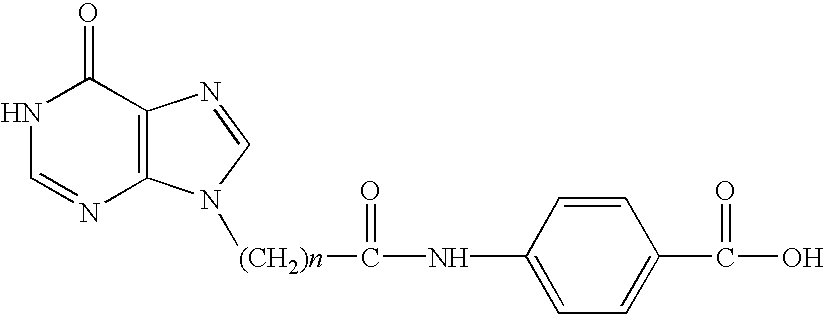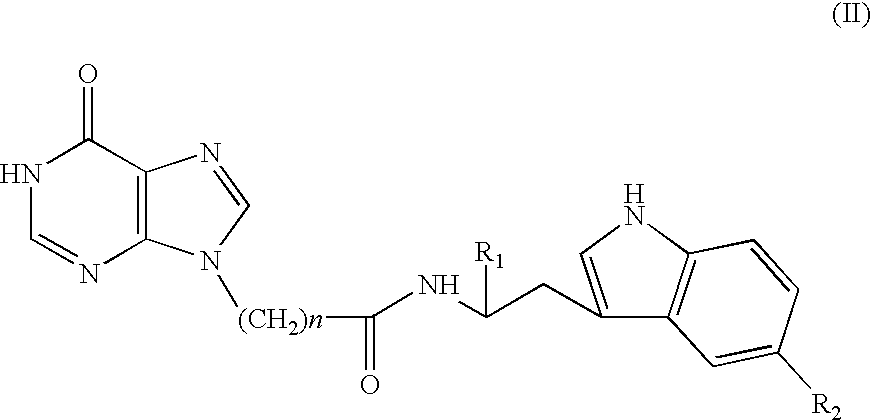Use of 9-substituted purine analogues and other molecules to stimulate neurogenesis
a purine analogue and neurogenesis technology, applied in the field of neurogenesis induction, can solve the problems of no method for replacing these lost neurons, and cannot form an organism independently, and achieve the effect of enhancing the effectiveness of the active ingredien
- Summary
- Abstract
- Description
- Claims
- Application Information
AI Technical Summary
Benefits of technology
Problems solved by technology
Method used
Image
Examples
example 1
Effects of the Bifunctional Purine Analogue N-4-Carboxyphenyl-3-(6-Oxohydr-opurin-9-yl)Propanamide in Stimulating Neural Stem and Progenitor Cell Proliferation
[0185] Experimental Design
[0186] In two separate experiments, AIT-082 was administered intraperitoneally to adult mice (5-7 per group) at 0.01-100 mg / kg. Saline was given as a negative control. Starting two hours after AIT-082 administration, animals received four intraperitoneal injections of bromodeoxyuridine (BrdU; 50 mg / kg each) at 3 hr intervals. BrdU is a thymidine analogue that is incorporated into DNA during synthesis and thus labels newly formed cells. Animals were perfused at 24 hr after the AIT-082 administration. This treatment regimen is outlined in FIG. 1.
[0187] Animals were perfused transcardially with 50 mL ice-cold phosphate buffered saline (PBS) and then 100 mL of 4% paraformaldehyde in PBS. Brains were removed, post-fixed in 4% paraformaldehyde for 24 hr at 4.degree. C., and then transferred to 30% sucrose a...
example 2
Effects of the Bifunctional Purine Analogue N-4-Carboxyphenyl-3-(6-Oxohydr-opurin-9-yl)Propanamide in Stimulating Neural Stem and Progenitor Cell Differentiation
[0193] Experimental Design
[0194] AIT-082 was administered intraperitoneally to adult mice (5-7 per group) at a dose of 1 -100 mg / kg. Saline was given as a negative control. Starting two hours after AIT-082 administration, animals received four intraperitoneal injections of bromodeoxyuridine (BrdU; 50 mg / kg each) at 3 hr intervals. Animals were perfused at 42 days after the AIT-082 administration. During these 42 days newly born neural stem cells have enough time to differentiate into neurons, astrocytes and other brain cells. This treatment regimen is outlined in FIG. 3.
[0195] Animals were perfused, brains treated and sections prepared as described for Example 1.
[0196] Every sixth section through the rostral-caudal extent of the hippocampus was immunostained with rat anti-BrdU paired with a Alexa 568 goat anti-rat IgG (red),...
PUM
| Property | Measurement | Unit |
|---|---|---|
| time | aaaaa | aaaaa |
| structure | aaaaa | aaaaa |
| water-solubility | aaaaa | aaaaa |
Abstract
Description
Claims
Application Information
 Login to View More
Login to View More - R&D
- Intellectual Property
- Life Sciences
- Materials
- Tech Scout
- Unparalleled Data Quality
- Higher Quality Content
- 60% Fewer Hallucinations
Browse by: Latest US Patents, China's latest patents, Technical Efficacy Thesaurus, Application Domain, Technology Topic, Popular Technical Reports.
© 2025 PatSnap. All rights reserved.Legal|Privacy policy|Modern Slavery Act Transparency Statement|Sitemap|About US| Contact US: help@patsnap.com



